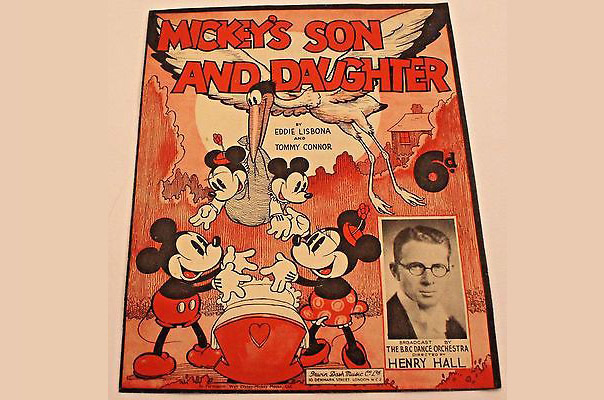
Once the denizens of Denmark Street (London’s answer to Tin Pan Alley), had gotten Mickey and Minnie Mouse spliced… at least on record… it was inevitable that they Do What Comes Naturally–and thus, that Mickey and Minnie should become parents.
“Mickey’s Son and Daughter” came out a good two years after “The Wedding Of Mister Mickey Mouse”. That’s a decent, respectable interval. There’ll be no scandal there!
Eddie Lisbona and Tommy Connor wrote this piece, basing its melody on a musical motif usually associated with the line “Boys and Girls Come Out To Play”. The lyric suggests general celebration at the birth of fraternal twins (the aforementioned son and daughter). There will be a party, complete with the presentation of a Gorgonzola cheese to the proud papa.
Most of he record companies and labels going around in London would have this song in heir catalogues. And some of the biggest names of the day were among those who recorded this tune, often as a “comedy quick-step”. Jack Payne (formerly with the BBC) and Henry Hall (currently with the BBC) had the song in their “books”, and recorded it.
So did two other major bands of the time, those of Lew Stone and Roy Fox.
Jack Jackson got to take on this song with his band, which was resident at London’s Dorchester Hotel.
And, for those whose pockets were shallow, Jay Wilbur’s group of studio musicians got to cut it for Crown, a nine-inch record sold only at Woolworth’s stores–for sixpence (equivalent to twelve cents in American money, at the exchange rates of the time.)
As far as I know, the song was not published in America. There are no US versions of it, anyway.
However, it must have been well-remembered in Great Britain.
During the 1960’s, there were a number of groups of what might be termed “performance artists” working London clubs. Among these wee The Alberts, The Temperance Seven (who tried to sound like a 1920’s dance orchestra such as the Savoy Orpheans)–and the Bonzo Dog Doo-Dah Band.
The “Bonzos” (as they would be known to their fans) had signed with Parlophone (the same label that had the Beatles) in 1966, and had put out a couple of singles. They didn’t make any of the British charts with such ditties as “My Brother Makes The Noises For The Talkies”. But they seem to have sold well enough that Parlophone asked for an album.
The album was called Gorilla, and included among its selections, “Mickey’s Son And Daughter”.
This was delivered in jokey style, with lots of squeaky sound effects,and even a line in sped-up “chipmunk” voices.
For some unaccountable reason, they ended the performance with the same, or a similar, paraphrase of “The Merry-Go-Round Broke Down” that ended some of Capitol Records’ kiddie discs of material featuring Warner Bros. characters. Go figure!
Next week: Disney finds a gold mine!


 James Parten has overcome a congenital visual disability to be acknowledged as an expert on the early history of recorded sound. He has a Broadcasting Certificate (Radio Option) from Los Angeles Valley College, class of 1999. He has also been a fan of animated cartoons since childhood.
James Parten has overcome a congenital visual disability to be acknowledged as an expert on the early history of recorded sound. He has a Broadcasting Certificate (Radio Option) from Los Angeles Valley College, class of 1999. He has also been a fan of animated cartoons since childhood.











































Did Disney receive any monetary compensation from these recordings? I would think something like this would qualify as merchandising and Disney would have to be compensated. Or is it fair game to write a song about a fictional character?
I do not know all the legal ramifications of this.
But it strikes me as being quite likely that the publishers might have had to pay a fee to Disney (or to whomever was handling the Disney business in the United Kingdom and Eire), for the use of the Mickey-and-Minnie imagery on the sheet music cover seen above.
The bottom of the sheet music cover itself says “By permission Walt Disney-Mickey Mouse Ltd.” It was absolutely a licensed product, and the cover artist was one of the major British Mickey Mouse artists of the time (annoyingly, one who has not been identified in modern times; it’s not Wilfred Haughton).
I’m not sure why so many readers of these sheet music columns are jumping to the conclusion that these pop songs were unlicensed—they were almost always sanctioned by Disney or (in the earliest days) by a local European distributor of Disney films.
C. Franz Koehler’s “A March for Mickey Mouse” (1934) was an exception, but it was one of very few.
I have found two different lyric variations of this song. The Bonzo version is an abbreviated version. I heard an interview with
Neil Inness where he referred to this song as “The Kidnapping pf Mickey’s Son and Daughter”. The BBC Orchestra version does have a kidnapping attempt at the end but this sheet music version does not. It also omits the roll call of animals.
ansibleysblog.blogspot.com/2008/06/truth-about-mouse.html